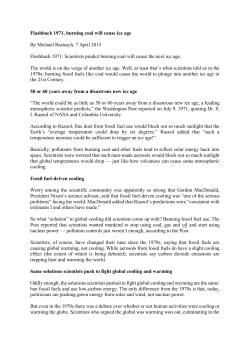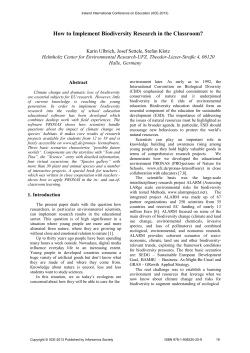
Fostering talent - Department of Astronomy
Comment: Forum phy sic s wor ld.com Fostering talent How do we select a cohort of promising scientists before they have made their discoveries? This is a fundamental challenge for academic planning, where even prestigious universities are plagued by “duds” or poor faculty hirings – those researchers who were labelled as geniuses with great promise when first employed but who, in retrospect, decades later, had little impact on science. Meanwhile, their contemporaries, who were not endorsed by prominent scientists and so moved to faculty positions at lesser schools, carried the day. Without mentioning names, this is a familiar occurrence, but why is it so prevalent? Senior scientists who serve on promotion, prize or search committees are often asked to evaluate the promise of their younger colleagues. One would naively expect them to approach this challenge in the same way that they would address a scientific problem, namely by studying all the available data and constructing a model that extrapolates into the future. In order to avoid biases, it would appear natural to adopt a “dynamical” model that considers the special initial conditions of an individual and allows for growth in forecasting that person’s future. For example, a young researcher who did not benefit from being nurtured by topquality mentors, or who came from a different culture or poorer background, should be given more slack. This is common sense, but is it common practice? My experience over the past three decades suggests otherwise. Young scientists are commonly assigned “static” labels without proper attention being given to their starting point or the growth of their career trajectory. Early-career evaluations reflect a frozen snapshot of achievements: for example, due to a frozen image of their qualifications when they graduated, it is common for science departments to underappreciate a faculty position applicant who graduated many years ago from the same department. These mistakes have serious consequences, as poor recruitments lead to drifts in the prestige of academic institutions. To make things worse, evaluators who picked a poor candidate often resist adjusting the opinion of the individual later on out of fear that admitting the need to do P hy sic s Wor ld Apr il 2015 iStock/Diane Labombarbe Science can only blossom if young researchers are rewarded for their growth rather than their “academic ancestry”, says Abraham Loeb Nurture Young scientists need continuing attention. Early-career evaluations reflect a frozen snapshot of achievements so would reflect an initial lack of foresight. Insisting on a static image that is out of sync with the growth of a successful researcher often leads to persistent attempts to shape reality to justify the preconception. The inconvenient truth is that evaluators with preconceptions have the power to allocate resources to justify their original static images. When serving on prize committees, for example, they can reward those whom they originally supported. But when serving on grant allocation committees, they can block support for others, even in the face of evidence that contradicts their early impressions. Such action leads to selffulfilling prophecies and can occasionally crash the rising career of brilliant individuals who were not recognized as such earlier on in their career. Aiming for diversity The above faults are sometimes driven by the misconception that scientific success is largely down to raw talent, which would be evident in any early snapshot of an individual. After all, Albert Einstein showed brilliance at a very young age. But this presumes a static view of science itself, while in reality the landscape of science has evolved dramatically over the century since Einstein’s day. Today, scientific information changes constantly and there are many more scientists around. In this climate, success is often linked to acquired skills, such as being able to adjust to rapidly changing intellectual landscapes – for example, big data – and to identify the right problem to work on while others are still searching in the dark. Today’s science also requires good “soft” skills, such as the ability to lead other scientists and to communicate results so that they promote progress. These skills take time to develop, so any model that attempts to forecast success reliably needs to include evolution and refrain from static images. Yet it sometimes seems that the guiding principles are completely off target. One obstacle to an honest evaluation process is that prominent scientists often seek to promote their own research programme in an effort to link it permanently to the mainstream. This tendency takes the form of senior scientists promoting their own students or group members well beyond what may count as fair play, which in the process suppresses independent thinking. Put simply, senior scientists too often measure success by how much a younger colleague replicates their own research agenda or set of skills. For example, if they are fluent with mathematical subtleties, they will identify success with mathematical skills. In faculty recruitment, this tendency for self-replication is dangerous because it might not stop at academic qualifications, but could easily spill over to an unconscious bias based on the replication of one’s own gender, race or ethnicity. There are multiple paths to success in science. Some paths are mathematical and quantitative while others are qualitative and require conceptual vision. Rather than replicating ourselves and preserving a static past, to secure a vibrant future we should aim for diversity and promote scientists of all varieties. Anyone serving on committees should resist static images of our younger colleagues and replace them with dynamical models by paying special attention to initial conditions and embracing evolution in our assessments. To cultivate innovation, we should always encourage creativity beyond the comfort limits that we establish for ourselves. To give an analogy, keeping a wide variety of matches in our matchbox will guarantee that not all of them will be duds. Hopefully, a few will light up in the dark to guide us how to move forward. Abraham (Avi) Loeb is chair of astronomy at Harvard University and director of the Institute for Theory and Computation at the Harvard-Smithsonian Center for Astrophysics, e-mail aloeb@cfa. harvard.edu 17
© Copyright 2025





















